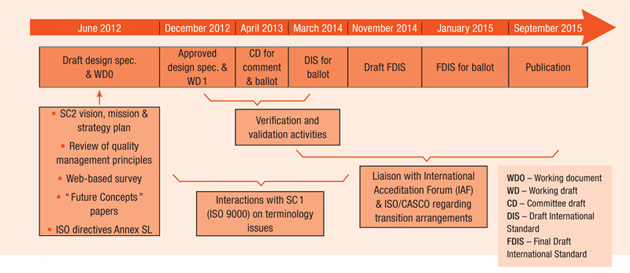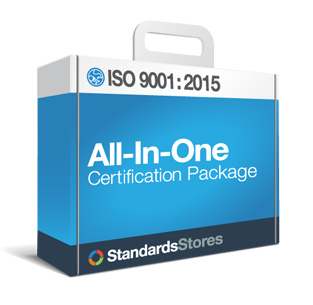An Insider’s View On The ISO 9001 2015 Revision
A Talk With ISO Panel Member JP Russel
It’s common knowledge that ISO 9001 is being revised with a proposed publication in 2015. There are many concerns about what changes ISO 9001:2015 will ultimately require in order for companies to become and then maintain ISO 9001 certification. The 9000 Store has asked key questions of industry expert J.P. Russell (Credentials below). What follows is part one of a two-part series asking key questions of Mr. Russell, with the first part focusing on the future of documentation and the second on auditing in the new world of ISO 9001:2015.
While Mr. Russell has been intimately involved in both this revision (and the last one ISO 9001:2008) he notes that “The following comments represent my personal observations and conclusions and not that of any organization I am a member or active participant. Nor is this an analysis of proposed requirement changes you may expect in the future.”
“What I do see forming up as changes at this point, may present some challenges in training auditors to understand some of the clauses and existing wording.”
J.P. Russell, member of the U.S. technical advisory group for International Organization for Standardization technical committee 176, responsible for the f ISO CD 9001:2015 revision.
Segment 1: How the ISO 9001:2015 Revision Affects The Need for Quality Management Documentation
The 9000 Store: From what we have been reading, the 2015 revision seems to be heading away from the need for formalized documentation. Yet you imply there will still be a need for documentation under the new standard. As one who sits on the organizational committee for the new standard, what’s your view of the documentation that will be required under ISO 9001:2015?
JP Russell: The new version of the standard will use the term “documented information.” What that tells me is that organizations will have more flexibility on the types and formats of documentation that they use to provide the necessary controls for their management systems. I think this flexibility means, for example, that you can use a flow chart, videotape, or a basic checklist. However, it will be true that you won’t necessarily have to [formally] document a procedure unless that’s what the organization feels they need.
The 9000 Store: When you say a “video” or something like that, can you compare and contrast the approach of documenting with those formats compared to a written document?
JP Russell: No because at this stage there are quite a few changes yet to come. It would be premature to talk about specifics like more control or less control. Basically, I think the language is going to be more open, and friendlier to service organizations rather than slanted to manufacturing, so more flexibility in the concept of documentation.
The 9000 Store: So, more documentation formats will be accepted, but what about content? Any changes there?
JP Russell: The big picture view would be that if you have a satisfactory system now, for the most part with the new standard, the same set of documents would be adequate. The opportunity would be to take another look and see where other formats like video may be more effective.
Segment 2: Auditing with Less Restrictive Documentation
The 9000 Store: How can you, as an auditor, tell whether a change in a communication medium for documentation really makes communicating a quality management system more effective?
JP Russell: You’re alluding to an issue that when standards get less prescriptive, then compliance requirements are subject to wider interpretation. That’s where training becomes more important. And the standard will still require that any document (video, audio, etc.) is still verifiable by an auditor.
The 9000 Store: It would seem that verification becomes the challenge for the people that do the transition training for auditors. If requirements become less objective and more subjective, auditors may have to spend more time understanding the organization before they can evaluate whether this new type of documentation actually represents what the organization does. So, is it too soon to tell what may happen to more traditional documentation requirements for areas such as procedures, GAP analysis, and or a quality manual?
JP Russell: Yes, it’s too soon to tell. The committee is looking at this from a very high level. So, from that view, some may say the standard is changing very little conceptually. However, from a detailed view, there may be many more changes. And that interests me as an auditor who has to go out there and ensure organizations are conforming to the standard on a word-for-word basis.
Documentation is not going away because management still needs control. To have control, you need what I call “predetermined methods.” And management needs to be able to verify that employees are performing according to that predetermined method. And so, organizations are still going to have a way to document what they do. Hopefully, the changes in this will make this process better. I’ve seen procedures written in such a way that there was no management control. For example, “Do this as appropriate, do that as appropriate.” And they were written so generically that they were worthless. What I do see forming up as changes at this point, may present some challenges in training auditors to understand some of the clauses and existing wording.
The 9000 Store: What do you see those challenges being?
JP Russell: During the last ISO 9001 update, there was a requirement that auditors go through “transition training” before they could audit to the new standard. Organizations were given 3 years to transition to the new standard. Because of the significance of the changes, I would expect something similar this time.
The 9000 Store: Is this similar to what happened with the AS9100 update where they have enough time to make the transition?
JP Russell: I would expect something like that here too.
ISO 9001:2015 Planned Implementation Schedule
As a member of the ISO technical committee (ISO/TC 176 Quality management and quality assurance, Mr. Russell projects that the standard will still meet the 2015 release deadline, although he says it may be published “later in the year.”
Segment 3: The Added Cost of ISO 2015 to the Certification Process
The 9000 Store: With this more “flexible” approach to documentation, the need for broader interpretation on the part of auditors sounds a bit like taking a course and the difference between memorizing it and understanding how it is truly to be applied. Will these changes increase the cost of ISO registration because you have to attack the process at a higher level of understanding?
JP Russell: That’s a good question… It’s going to “cost” an organization probably in training and perhaps in restructuring their documentation to aid in their implementation. Is it going to be more than a company that has no QMS? Probably not.
The 9000 Store: So, this might have a greater impact on a group that is seeking re-certification than those who are being certified initially?
JP Russell: Yes, I think so. Although as I said before, organizations who are recertifying can use their existing documentation if it accurately reflects their company’s processes. At a higher level, you could say this is really not much of a change, but there will be some cost in reorganizing their documentation at the very least. For instance, there’s been a lot of interest in how to incorporate risk management into the QMS. We talk about the “process approach,” which was in the 9001:2008 revision, but it wasn’t in the requirements clause 4. And that may find its way into a requirements section. So, there will be some new elements, which hopefully make for a more effective QMS that does the right things for the right reasons.
The 9000 Store: So, you’re saying that the new revision is not throwing out the discipline that comes with a structured process, you’re just widening the scope of what could be considered part of that process?
JP Russell: That is correct. Now there would be critics that say, “we’re no longer going to have documented processes and if we try to audit, there will be confusion.” That’s probably not going to happen. Most companies are level-headed, and they know they need control whether it’s finance or operations, or quality.
JP Russell Profile
J.P. Russell is the founder and managing director of QualityWBT Center for Education. He also is an ASQ fellow, ASQ-certified quality auditor, and a voting member of the American National Standards Institute/ASQ Z1 committee. He has authored numerous guides on the auditing process including “The Process Auditing and Techniques Guide,” “The Internal Auditing Pocket Guide” and “After the Quality Audit: Closing the Loop on the Audit Process.” Russell is a recipient of the Paul Gauthier Award from the ASQ Audit Division. Most relevant for the upcoming ISO 9001 revision, he is a member of the U.S. technical advisory group for International Organization for Standardization technical committee 176, which is charged with drafting ISO 9001:2015.
Coming: How ISO 9001:2015 May Change The Role Of An Auditor



